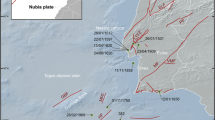Summary
Attention is paid to the fact that with catastrophic earthquakes 80–90% of human casualties and material damage is associated not with the earthquake proper but with subsequent phenomena, primarily landslides and collapses. Their main reasons are seismic accelerations, change of the gradient angle of unstable planes and thixotropic affects on grounds.
Nine types of seismogenic landslides and collapses are distinguished. It is underlined that the greatest landslides and collapses in highly seismic regions have a tendency to be repeated in the same regions. For the establishment of such regions the palaeoseismogeological method is of great importance. It has been worked out at the Institute of the Earth's crust, Siberian Branch of the USSR Academy of Sciences.
Résumé
Le présent article attire l'attention sur le fait qu'au cours de grands tremblements de terre, de 80 à 90% des morts et des dégâts matériels sont liés non au seïsme lui-même, mais aux phénomènes qui l'accompagnent, en particulier les glissements et les éboulements de terrain. Leurs causes principales sont les accélérations sismiques, le changement de l'angle d'inclinaison des plans instables et la dilution thixotrope des sols.
On distingue 9 types de glissements et d'éboulements de terrain. On souligne que les plus grands glissements et éboulements de terrain dans les regions très sismiques peuvent avoir lieu dans ces mêmes régions. Alors, pour mettre en évidence ces dernières, il faudrait appliquer la méthode paléoseismologique, élaborée par l'Institut de la Croûte terrestre de la Division sibérienne de l'Académie des Sciences de l'URSS, qui a une grande valeur pratique.
Similar content being viewed by others
References
DAVIS S.N.—KARZULOVIC, K. (1963): Landslides at Lago Rinihue, Chile: Bull. Seismol. Soc. America, 53, No 6.
FEDORENKO V. C. (1968): Tectonic and seismic features and their importance in the formation of catastrophic collapses and landslides. In: Problems of Engineering Geology and Soil Science. 2. MGU (Dept. Min), Moscow.
FLORENSOV N.A.—SOLONENKO V.P. (1965/66): The Gobi-Altai earthquake. Jerusalem-Washington, Jerusalem, London.
GLUCHOV I. G. (1959): On earthquakes as a factor of activation of Mountainous Crimea.-Vestnik MGU, No 4.
HADLEY J.B. (1964): Landslides and related phenomena accompanying the Hebgen Lake earthquake of August 17, 1959.—Geol. Survey Profess. Paper.
HANSEN W.R.—ECKEL E.B.—SCAEM W.E.—LYLE R.E.—GORGE W.—CHANGE G. (1966): The Alaska earthquake March 27, 1964.—Geol. Survey Profess. Paper, No 541.
HARRISON J.V.—FALCON N.L. (1937): The Saidmarreh landslip, south-west Iran. Geograph. Journal, 89, No 1.
KLIMENKO A.I.—TSAREV P.V. (1971): A seismogenic landslide in Dagestan.—In: Problems of engineering Geology of North Caucasus. Sochi.
KURDJUKOV K.V. (1964): Recent tectonic movements and traces of large seismic shocks on the northern slope of the Zailiisky range.—In: Zones of the Earth's crust with renewed activity, recent tectonic movements and seismicity. M., “Nauka”.
MORPHY L.M.—BRAZEC R.J. (1964): Seismological investigations of the Hebgen Lake Earthquake.—Geol. Survey, Profess. Paper, No 435.
PAIN C.F.—BOWLER J.M. (1973): Denudation following the November 1970, earthquake at Madang, Papua New Guinea. —Z. Geomorph., Suppl. 18.
PLAFKER, G.—ERICKSEN G.E.—CONCHA J.F. (1971): Geological aspects of the May 31, 1970 Peru earthquake.—Bull. Seismol. Soc. America,61, No 3.
SOLONENKO V.P. (1950): Dynamic phenomena, associated with the neotectonics of East Siberia.—AN SSSR Transact.,72, No 1.
SOLONENKO V.P. (1965): Active tectonics in the Pleistocene area of the Muya earthquake.—Izv. AN SSSR, geol. ser., No 4.
SOLONENKO V.P. (1973): Palaeoseismogeology.—Izv. AN SSSR, Earth Physics, No 9.
SOLONENKO V.P. (1974): Seismogeology and the problem of earthquake prediction. Geology and Geophysics, No 5.
SOLONENKO V.P. (1976): Seismovibrational collapses and ground avalanches. Geological regularities of the development of landslides, collapses and mudflows. Issue 2, Publishing House of MGU
SOLONENKO V.P.—KHROMOVSKIKH V.S. (1974): Large Earthquakes of the Great Caucasus.—Nature, No 6.
TAZEFF H. (1960): Interprétation des glissements de terrain accompagnant le gand séisme du Chili.—Bull. Soc. Belge géol., LXIX, fasc. 2
THE PERU EARTHQUAKE (1970): a special study.—Bull. Atomic Sci,26, No 8.
WEISCHET W. (1963): Further observations of geologic and geomorphic changes resulting from the catastrophic earthquakes of May, 1960, in Chile.—Bull. Seismol. Soc. America,53, No 6.
ZOLOTAREV G.S.—MATVEEV YU. D.—SHESHENYA N.I. (1968): Types of rock falls and landslides of Toktogul G.E.S. on the Nazin river and problems of their forecasting. Problems of Engineering Geol. and Soil Science, 2, MGU (Dept. Min.).
Author information
Authors and Affiliations
Rights and permissions
About this article
Cite this article
Solonenko, V.P. Landslides and collapses in seismic zones and their prediction. Bulletin of the International Association of Engineering Geology 15, 4–8 (1977). https://doi.org/10.1007/BF02592633
Published:
Issue Date:
DOI: https://doi.org/10.1007/BF02592633




